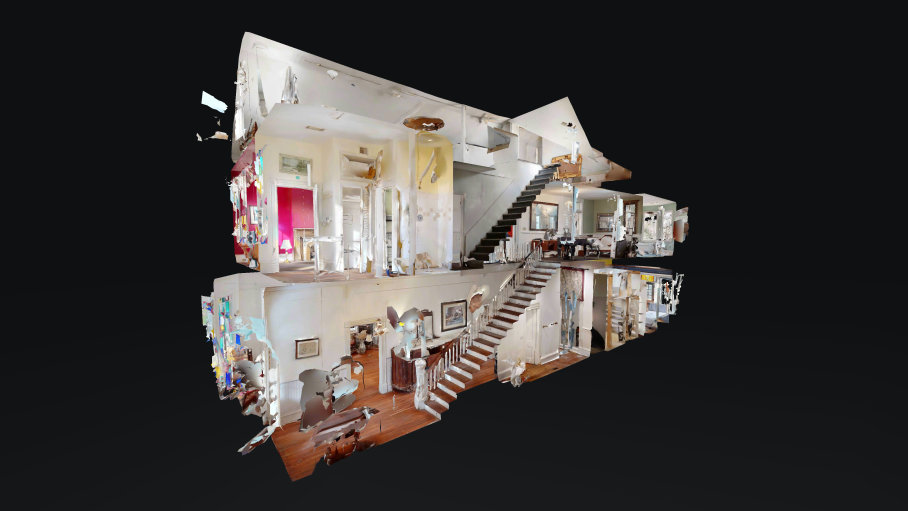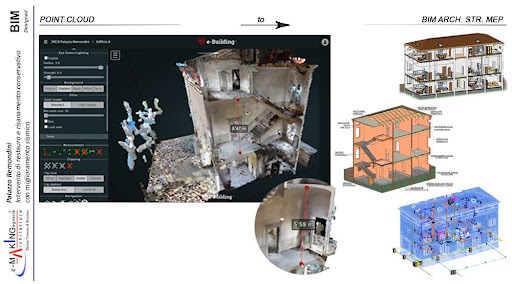Historic Building Restoration & Digital Twin Technology: How To Experience The Past In The Present
Modernizing History With Digital Twins
Historic buildings are a precious resource, works of art with great historical significance. With every historic building we lose, we lose a piece of history itself. Historic building restoration is a priority for many new homeowners and community heritage preservation organizations. But, historical building restoration brings with it a number of unique challenges.
Are historic building restoration projects worth the trouble? How can you be sure projects are up to code? How do you restore historic sites when you’re missing building documentation?
Fear not. With some prep work and a touch of modern technology, you can safely restore existing buildings while maintaining the historical character that makes them unique.
Why should historic buildings be restored?
Every generation has its own style, and buildings are no different. If you’re still not sold, drive through the newest development in your area, and then the oldest. Historic buildings are essentially time capsules, each structure telling a one-of-a-kind story that’s irreplaceable once lost.
Fortunately, many people make historic preservation a priority, rather than tear these sites down. For example, the University of Wolverhampton, located west of Birmingham, England, made sure to maintain the charm of the historic structure that was involved in their £120-million super-campus project.
Beyond keeping these historic buildings from winding up in a pile of rubble, why go through all the trouble?
Historic buildings act as teachers
Historic buildings also act as great teachers, showing today’s aspiring architects and engineers the lasting nature of quality craftsmanship. When the University of Wolverhampton proceeded with their campus project, they made sure to capture the educational aspect of historic buildings. Using Matterport’s Digital Twin platform, they captured the entire renovation project and turned it into virtual tours for students.
Even when the project is completed, students will be able to revisit the historical building, as well as the construction site at each stage of the upgrade.
Historic buildings are used for record-keeping
Historic building restoration is also important as a form of record-keeping, or capturing tradition for future generations. Many modern buildings are streamlined and built using templates. Older structures were often tailor-made for a specific purpose, resulting in a unique building that acts as a record of that time period. For example, Tenzan Sake Brewery, based out of Japan, has operated for more than 145 years.
One of the oldest sake brewers in the world, Tenzan was greatly concerned with maintaining the original history and character of their facility when considering a renovation. Using Matterport, Tenzan created a digital twin of their original facility, allowing anyone to experience the facility and traditional methods of sake brewing.
Things to consider during the historic building restoration project
Historic building restoration projects aren’t as straightforward as new builds, or even more modern restorations. Whenever you’re attempting to restore an original building, there are several major considerations to take into account, many of which vary depending on the type of building.
Lack of documentation
Most engineers and architects have encountered a project that lacks documentation. But, in the case of historic building renovation projects, it’s not uncommon for there to be little-to-no documentation at all. This includes as-built documentation, blueprints, notes, etc. This makes it especially important that you do a thorough inspection of the historic structure, and that you capture existing conditions and generate the best as-built documentation before starting anything.
For example, Perkins & Will, an architecture and design firm was tasked with enhancing the lighting for Chicago’s Wrigley Building for its 100th anniversary. Perkins & Will used Matterport’s digital twin technology to implement a non-invasive solution for scanning the historic building safely and quickly to understand the intricate design and come up with a seamless lighting solution.
“Matterport gave us a true understanding of the building’s physical properties,” Nick Cameron, director of digital practice at Perkins & Will says. “We never had to go back and re-measure anything because Matterport captured it correctly the first time. It made us feel confident that we were doing a good job and providing our client with the right design approach.”
Read the full case study here.
Safety concerns
Simply put, many older buildings are unsafe, whether the foundation is going or there are toxic coatings applied to surfaces. This is especially true if the building has fallen into a state of total disrepair. While you can likely make the structure safe again, there’s still a safety risk for your team during the renovation process. When capturing existing physical conditions, you need more than just the measurements and design of the building. Visual details like the state of the interior are crucial to understanding the level of restoration required.
You also have to ensure the structure is safe and meets modern building codes once you’re done with the project. Depending on the age of the historic property, this could entail tearing into walls to redo wiring, having to redo supports under the building, etc.
Matching original materials
Modern buildings use modern materials, making it easy to match walls, flooring, and so on any time you’re making changes. This isn’t the case when you’re dealing with a historic project, as original building materials may not exist anymore.
Trying to match original materials can result in a wild goose chase of hunting for materials, or having to consult an expert capable of replicating the type of material you need. In either event, you’re looking at more time and money than you would with new construction, where you can simply buy new materials.

Trying to match materials, like the wood flooring in this building, is especially difficult when you factor in the aging of the existing panels
Finding the right expertise
Historic building restorations are different from your typical new build or renovation of a more recent structure. When you’re working on a historic building restoration project, you could be dealing with a structure that’s hundreds of years old. This means the building methods, materials, safety concerns, style, and more are drastically different from what modern engineers and architects are used to dealing with.

Església de Sant Esteve de la Doma showcases the role of historic expertise, as this structure has remained largely intact since 1685 It’s essential that you have the right experts for the job, including a historic preservation consultant, as they can help you prepare for potential challenges and ensure you don’t compromise the integrity or history of the building.
Project cost
Simply put, historic building restoration is typically more expensive than projects concerning modern structures. Additional care is required during every step to ensure nothing is damaged, materials are harder to find, and the right experts are critical to the success of the project — all of which add to the cost.
The role of as-built documentation in restoring historic buildings
As-built documentation comes from as-built surveys and as-built drawings, which offer a detailed look at a building exactly as it was built (not designed). Thorough as-built documentation is crucial in any build, as it informs future renovations and also acts as a receipt of sorts, showing what work was done and why.
Unfortunately, original as-built documentation isn’t always available for historic sites. But, this doesn’t mean you can’t make as-built documentation before starting. In fact, creating as-built documentation for historical restoration projects is an especially good idea, for a number of reasons.
1. Preserving the historic structure
By capturing detailed as-built documentation of a historic site before you do any work, you’re creating a baseline of what the structure looked like at that moment in time. This can help you prioritize the integrity of the historic significance of the structure as you move forward with the restoration, giving you a reference point to go back to throughout the project.
2. Assists with compliance
Creating as-built documentation throughout the project, at each stage, shows the quality of work you’re doing and helps with compliance as you move forward. Regulatory agencies will want proof the building meets modern standards, and as-built documentation can be a great supplemental doc here.
3. Informs future restoration
Historic sites will inevitably need further restoration services down the line. As-built documentation helps the next crew, showing them all the work that was done, where utilities are located, etc.
4. Helps with cost management
Capturing existing conditions with as-built surveys before you start any construction can help you plan ahead. Better planning gives your team the chance to look ahead for any potential challenges, map out potential material needs, and ultimately reduce financial waste. When you’re dealing with historic building restoration, cost management and minimizing financial waste are hugely important.
Reviving the past: How digital twin technology improves the historic building restoration process
While as-built documentation is critical to the success of historic building restoration, it’s also typically time-consuming, requiring costly scans and manual effort. This often prevents teams from delivering consistent as-built documentation throughout a project. With Matterport's digital twin technology, this doesn’t have to be the case.
The Matterport Digital Twin platform uses cameras and LiDAR technology to reduce the time it takes to scan for a 3D model, while still providing detailed digital twins perfect for as-built documentation and virtual tours. This allows you to quickly and efficiently create as-built documentation throughout the build. Not only this, Matterport scans can be turned into BIM and point cloud files and quickly ported to Revit via built-in integration.
Bologna-based digital engineering firm, e-Making, was tasked with restoring Italy’s Remondini Palace. Built in 1600, Remondini Palace had sustained severe damage from an earthquake and was nearly lost. To drive collaboration and enhance their restoration efforts, e-Making partnered with Matterport. Using Matterport digital twins, e-Making was able to quickly create as-built documentation.
e-Making then used Matterport measurements within the digital twin files, allowing them to get accurate measurements of any scanned surface — no matter where they were. Their project leads, engineers, and architects were able to remotely view these scans and measurements, and communicate via Matterport Tags. The end result? Seventy percent time savings and 20% cost savings, compared to traditional condition survey methods.

e-Making reduced survey time by 70% and cost by 20% using Matterport scans
Whenever you approach a historic building restoration project, your goal is always to preserve history as best you can. Use the digital twin technology of today to help you do the best job possible at ensuring these one-of-a-kind historic sites aren’t lost to time.
Here are the answers to the most frequently asked questions to help you prevent the buildings of the past from fading away.
